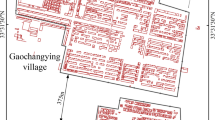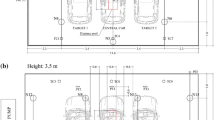Many years of use of high pressure and oxygen enrichment of the blast to intensify blast-furnace smelting have shown that the main reason these measures are not very effective and are sometimes even harmful is that the wind rate is reduced when they are used together. In essence, the oxygen that is already present in the blast air is replaced by expensive technical oxygen. The article explores the reasons that this situation exists. It is shown that the problem of increasing the oxygen content of the blast – which is the only direct goal of using intensifiers – is more simply and more cheaply solved by reducing the resistance of the air-blower–blast furnace–gas-cleaning equipment system to the blast that is supplied to the furnace. In particular, more oxygen can be delivered to the furnace via the blast by increasing the number of tuyeres and/or increasing the tuyeres’ diameter.

Similar content being viewed by others
References
I. F. Kurunov, “The blast-furnace process – is there an alternative?” Metallurg, No. 4, 40–44, 2012.
S. T. Pliskanovskii, I. G. Tovarovskii, Yu. A. Prikhod’ko, et al., “The state of blast-furnace smelting technology and the main trends in its improvement,” Proc. 5th Int.. Congr. Blast-Furn. Operat. Production of Pig Iron at the Turn of the Century, Porogi, Dnepropetrovsk (1999), pp. 31–37.
A. D. Gottleib, The Blast-Furnace Process [Russian translation], Metallurgizdat, Moscow (1958).
Discussion on the Operation of Blast Furnaces at High Pressure, UkrNTO ChM, Dnepropetrovsk (1958).
I. Z. Kozlovich, Reduction and Oxidation in Large Blast Furnaces, Metallurgizdat, Moscow (1951).
Z. I. Nekrasov, P. G. Netrebko, F. N. Moskalina, et al., “Trial heat in a 2000-m3 blast furnace with up to 30% oxygen enrichment of the blast,” Stal, No. 10, 887–894 (1971).
Z. I. Nekrasov, S. V. Kolpakov, V. F. Andreev, et al., “Trial heats in a 2000-m3 blast furnace on a blast with an oxygen content up to 35%,” Stal, No. 2, 97–104 (1973).
Z. I. Nekrasov, N. S. Antipov, N. M. Mozharenko, and F. I. Moskalina, “First trial operation of a 2000-m3 blast furnace at the NLMZ with a blast having an oxygen content up to 40%,” Stal, No. 7, 7–9 (1981).
M. A. Pavlov, The Metallurgy of Pig Iron, Vol. II, The Blast-Furnace Process, Metallurgizdat, Moscow (1949).
V. A. Sheremet, “Sintering, blast-furnace smelting, and coke production at the KGGMK “Krivorozhstal,” Proc. 5th Int.. Congr. Blast-Furn. Operat. Production of Pig Iron at the Turn of the Century, Porogi, Dnepropetrovsk (1999), pp. 6–14.
V. A. Sheremet, “Growth of blast-furnace smelting at the Krivoy Rog State Mining-Metallurgical Combine “Krivorozhstal.” Proc. Int. Sci.-Tech. Conf. Commem. 70th Anniv. KGGMK Krivorozhstal, Theory and Practice of Pig-Iron Production, Krivoy Rog (2004), pp. 5–12.
E. G. Teterevyatnikov and V. N. Andronov, “Operation of a blast furnace with a top-gas pressure of up to 1.3 psig,” Stal, N. 3, 200–204 (1957).
B. N. Starshikov and M. L. Lavrent’ev, “Operation of a blast furnace with high pressure,” Byull. TsIINUM, No. 18, 1–8 (1959).
L. Ya. Levin, E. T. Solov’ev, and V. D. Kailov, “Experience in attaining high performance indices for blast-furnace smelting,” Stal, No. 7, 587–592 (1962).
V. N. Andronov, Extraction of Ferrous Metals from Natural and Technogenic Raw Materials. The Blast-Furnace Process, Nord-Press, Donetsk (2009).
E. G. Donskov, V. P. Lyalyuk, and V. V. Severnyuk, Operation of Blast-Furnace Tuyeres, Porogi, Dnepropetrovsk (1997).
M. Ya. Ostroukhov, “Toward a theory of the operation of blast furnace with elevated pressure,” Stal, No. 10, 882–886 (1954).
A. N. Ramm, “The possibilities of intensifying blast-furnace smelting by increasing gas pressure,” Trudy LPI im. Kalinina. Metallur. Chuguna, Metallurgizdat, Moscow (1955), Iss. 179, pp. 118–126.
V. D. Pashkov, “Increasing the pressure in a blast furnace,” Stal, No. 3, 219–227 (1952).
E. A. Nitskevich, Heat and Power Engineering of Blast-Furnace Smelting, Metallurgiya, Moscow (1966).
E. G. Donskov, S. V. Pustovetov, and V. V. Taranovskii, “Optimizing the operation of blast furnaces under unstable smelting conditions,” Stal, No. 4, 19–22 (1998).
E. G. Donskov, V. P. Lyalyuk, and A. D. Donskov, “The Darcy–Weisbach equation and some results of its use in the theory and practice of blast-furnace smelting,” Stal, No. 4, 10–15 (2013).
E. G. Donskov and V. P. Lyalyuk, Controlling the Blast Furnace, Palmarium Academic Publishers, Saarbrücken, Germany (2013).
Author information
Authors and Affiliations
Corresponding author
Additional information
Translated from Metallurg, No. 4, pp. 40–46, April, 2014.
* Point of discussion.
Rights and permissions
About this article
Cite this article
Donskov, E.G., Lyalyuk, V.P. & Donskov, A.D. Use of the Blast Furnaces at Krivorozhstal to Illustrate the Prospects of Blast-Furnace Smelting and Certain Aspects of its Current State* . Metallurgist 58, 256–263 (2014). https://doi.org/10.1007/s11015-014-9898-y
Received:
Published:
Issue Date:
DOI: https://doi.org/10.1007/s11015-014-9898-y




